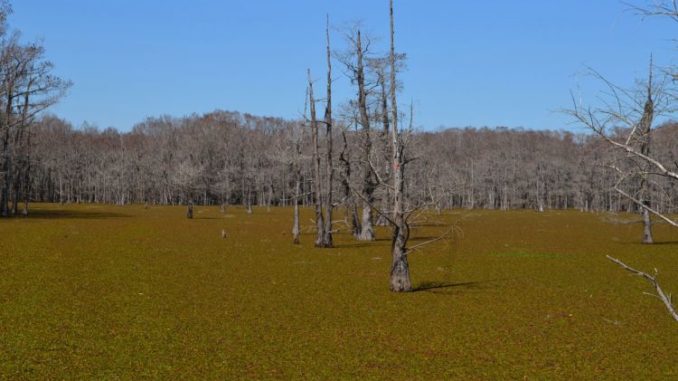
Rickey Lee sounded worried the night before the trip.
“Man, man, man, the salvinia (pronounced ‘silvania, north Louisiana style) is as bad as I’ve seen it. I tried to fish the middle of the lake today and only found one spot I could get in to.
“I drove through salvinia for miles.
“What’s bad is that the wind will move it and where you catch fish one day, you can’t fish the next day.”
Lake Bistineau is known for two things — big largemouth bass and the floating aquatic weed pest giant salvinia, known to biologists as Salvinia molesta. The last part of its technical name gives some clue to its habits.
According to Louisiana Department of Wildlife and Fisheries (LDWF) biologist manager Jeff Sibley, the green scourge has been on the lake for 12 years. The department has declared the lake a poster child for salvinia control.
Their war on salvinia is three-pronged: chemical, mechanical and biological. LDWF has spent millions of dollars on chemical sprays and continues to use them in areas of high concentrations of the weed.
Mechanical control is done with water level draw-downs, a tool that has been in the department’s toolbox for management of the lake since 1955. “New lakes are like teenagers — great health,” explained Sibley. “But like us, they age and develop aches and pains.”
The “aches and pains” Sibley referred to were symptomized by poor fishing. “Each lake is different. Lake Bistineau is essentially a flooded swamp, which if not dammed, would naturally de-water seasonally.
“Our drawdowns mimic what would happen naturally. Most lakes need to be de-watered at some point to prevent eutrophication.”
Done to firm up the exposed lake bottom when it dries out, drawdowns also work to control aquatic weeds by stranding them on land and killing them.
“A lot of folks around the lake want it to be full all the time,” Sibley went on. The lake is heavily used by anglers and waterfowl hunters, but others enjoy water sports like skiing and tubing. All of the various user groups’ wishes don’t always line up.
“But with no control effort, salvinia would quickly make the lake very unusable for everyone.”
Biological control, at the present time, hinges around the establishment of the salvinia weevil. Looking very much like a cotton boll weevil, but smaller, the creature has a voracious appetite for salvinia plants.
LDWF has stocked 2 ½ million weevils in the lake, but so far Lake Bistineau is slightly north of where the animal can successfully survive winter temperatures. The latest effort occurred on June 24, 2017, when the department sponsored a “Weevil Day.”
Plants infected with weevils from Iatt lake were distributed to 86 volunteers, who in turn planted them in the lake. The plants were calculated to contain 123,600 adult weevils and many more eggs and larvae.
The weevils have successfully overwintered in Iatt Lake and the hope is that they are a slightly more cold tolerant strain.
In conclusion, Sibley offered that, “we have the ability to manage salvinia to allow the lake to be usable, but not in the historical sense.
“If I had a silver bullet, I would use it.”